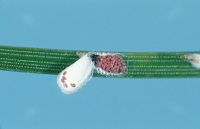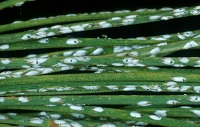Chionaspis pinifoliae
Hosts
Scots pine, Colorado spruce, white spruce and other pines and spruces
Appearance and Life Cycle

Photo credit: Therese Arcand, Natural Resources Canada
Pine needle scale is a microscopic insect that overwinters as an egg under the scale formed by the mother. Nymphs emerge in early June and search for suitable feeding sites on old needles. In 3 to 4 weeks the male nymphs form a narrow, white, waxy protective scale about 1.5 millimetres (mm) in length. Meanwhile the females remain as free- feeding insects without a scale covering. During the next 3 weeks the males develop into winged adults and emerge from the scales to mate with the wingless females. By mid-August the females produce a smooth, white, oblong shaped scale about 3 mm in length. Each female produces about 40 overwintering eggs under the protective scale. There is one generation per year.
Damage

Photo credit: Therese Arcand, Natural Resources Canada
Pine needle scale causes damage by inserting its mouthparts into the needle and extracting sap. This feeding causes a yellowish-green area to form around each puncture. In severe cases yellow spots merge, needles drop prematurely and the tree assumes a dull, unhealthy appearance. A severe infestation would be 20 or more scales per spruce needle and 50 or more per pine needle. Trees with repeated heavy infestations have reduced vigor and annual growth and become more susceptible to secondary insects.
Control
Lady beetles, parasites and weather contribute to the natural control of the scale. When natural controls fail, serious damage can be prevented by applying insecticides. Insecticides recommended include: dimethoate, malathion, diazinon or carbaryl. Two applications may be required; once in mid-June when nymphs are unprotected and searching for feeding sites, and a second in early August to control the females before they produce their protective scale covering.